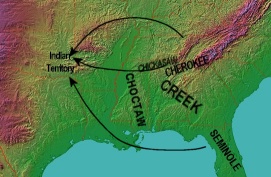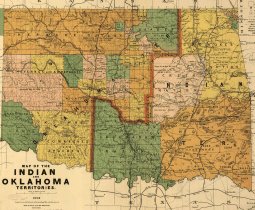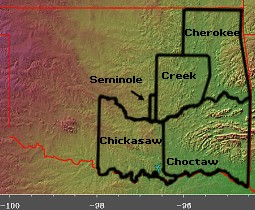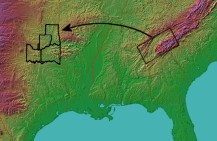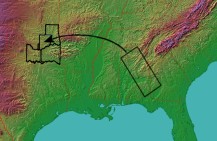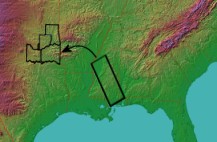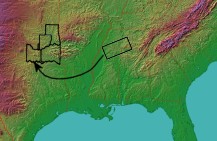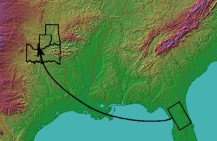The Cherokees settled in the northeast of the new territory. Their homes in the Appalachians had been dominated by mountain ranges, rivers, and forests. In the foothills of the Ozark Mountains and the valleys of the Illinois, Arkansas, Grand, and Verdigris rivers they found lands similar to what they had known before, but foreign because they were brought there under duress. Of the five tribes, the Cherokee suffered probably the harshest conditions during their removal. In the southeast, they had lived in villages along river valleys where they planted their crops on river terraces and hunted over large areas. In their first year in the west, they planted along the Arkansas River, which flooded, as it did regularly, and the first crops were washed out.
 |
|
 |
The Creek people settled in the central part of the Indian Territory. The northern and southern branches of the Canadian River bounded their territory, and numerous creeks fed into those rivers. The low hills and a narrow band of dense forest known as the Cross Timbers distinguished the area.
The Choctaws moved into the area of the San Bois and Ouachita mountains and the Kiamechi river in the southeast region of the territory. The piney woods, mountains, and rivers of the region were similar to those of the southeastern area in Mississippi. Although the topography was familiar, the Choctaws had had to leave behind their homes, fields, crops, and whatever livestock they possessed.
The Chickasaws moved into Choctaw territory in 1837 with the promise that they would occupy its western portion, the land between the Cross Timbers and the open space of the Plains. Because the land in what was known as the Indian Territory had been assigned to the Creeks, Cherokees, and Choctaws, there was no place for the Chickasaws. They had sold their eastern lands to the United States government for approximately $500,000, with which they could buy a new homeland. With this money, they leased land from the Choctaws. The money also created a trust fund that yielded an income for the tribe of between $60,000 and $75,000 a year. They could live on annuity payments without having to establish farms. For the Chickasaws, removal led them into a cash economy and a political situation that stifled their dependency upon the natural environment.
The Seminoles resisted removal in a series of hard-fought and costly wars from the 1810s to the 1850s. In 1835, about 4,000 Seminoles were captured and sent to the Indian Territory, where they were located in the western section of the Creek territory. Another small group was sent from Florida in the late 1850s, when the government campaign to remove the southeastern Indians came to an end.
M. L. Van Horn 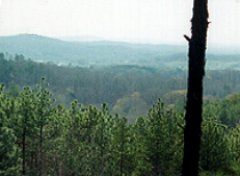
Northeast Alabama |
C. S. Lewallen 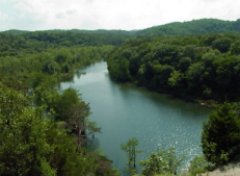
Southeast Oklahoma |
"the hilly, wooded southeastern part of the Territory that resembled their homelands in the southeast [U.S.]"
|
|
As the tribes entered their new lands, the one thing they would not do was move beyond the hilly, wooded southeastern part of the Territory that resembled their homelands in the southeast. Further west, the dramatic opening of the Great Plains with its vast, treeless, arid expanses of territory, was foreign to their experience. In addition, it was dominated by Kiowas, Comanches, Wichitas, and Apaches—buffalo-hunting, highly mobile societies whose raids were a threat to the settled villages of the Southeastern tribes. Although their treaties guaranteed their rights to lands all the way to the headwaters of the Arkansas, Red, and Canadian Rivers, the environment in the west created a natural boundary beyond which the southeastern tribes would not move.
Denver Public Library  Plains in southwestern Oklahoma near Fort Sill, with Kiowa or Apache camp, c. 1875
|
"the environment in the west created a natural boundary beyond
which the southeastern tribes would not move"
|
|

